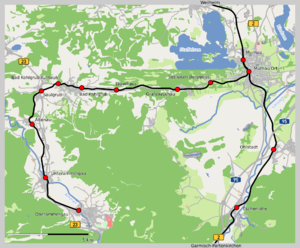Ammergau Railway
| Ammergau Railway | |||||||||||||||||||||||||||||||||||||||||||||||||||||||||||||||||||||||||||||||||||||||||||||||||||||||||||||||||
|---|---|---|---|---|---|---|---|---|---|---|---|---|---|---|---|---|---|---|---|---|---|---|---|---|---|---|---|---|---|---|---|---|---|---|---|---|---|---|---|---|---|---|---|---|---|---|---|---|---|---|---|---|---|---|---|---|---|---|---|---|---|---|---|---|---|---|---|---|---|---|---|---|---|---|---|---|---|---|---|---|---|---|---|---|---|---|---|---|---|---|---|---|---|---|---|---|---|---|---|---|---|---|---|---|---|---|---|---|---|---|---|---|---|

ET 426 in Oberammergau
|
|||||||||||||||||||||||||||||||||||||||||||||||||||||||||||||||||||||||||||||||||||||||||||||||||||||||||||||||||
| Overview | |||||||||||||||||||||||||||||||||||||||||||||||||||||||||||||||||||||||||||||||||||||||||||||||||||||||||||||||||
| Native name | Ammergaubahn | ||||||||||||||||||||||||||||||||||||||||||||||||||||||||||||||||||||||||||||||||||||||||||||||||||||||||||||||||
| Type |
Heavy rail, Passenger rail Regional rail |
||||||||||||||||||||||||||||||||||||||||||||||||||||||||||||||||||||||||||||||||||||||||||||||||||||||||||||||||
| Status | Operational | ||||||||||||||||||||||||||||||||||||||||||||||||||||||||||||||||||||||||||||||||||||||||||||||||||||||||||||||||
| Locale | Bavaria | ||||||||||||||||||||||||||||||||||||||||||||||||||||||||||||||||||||||||||||||||||||||||||||||||||||||||||||||||
| Termini |
Murnau Oberammergau |
||||||||||||||||||||||||||||||||||||||||||||||||||||||||||||||||||||||||||||||||||||||||||||||||||||||||||||||||
| Stations | 11 | ||||||||||||||||||||||||||||||||||||||||||||||||||||||||||||||||||||||||||||||||||||||||||||||||||||||||||||||||
| Line number | 5451 | ||||||||||||||||||||||||||||||||||||||||||||||||||||||||||||||||||||||||||||||||||||||||||||||||||||||||||||||||
| Operation | |||||||||||||||||||||||||||||||||||||||||||||||||||||||||||||||||||||||||||||||||||||||||||||||||||||||||||||||||
| Opened | 5 April 1900 | ||||||||||||||||||||||||||||||||||||||||||||||||||||||||||||||||||||||||||||||||||||||||||||||||||||||||||||||||
| Owner | Deutsche Bahn | ||||||||||||||||||||||||||||||||||||||||||||||||||||||||||||||||||||||||||||||||||||||||||||||||||||||||||||||||
| Operator(s) | DB Regio | ||||||||||||||||||||||||||||||||||||||||||||||||||||||||||||||||||||||||||||||||||||||||||||||||||||||||||||||||
| Technical | |||||||||||||||||||||||||||||||||||||||||||||||||||||||||||||||||||||||||||||||||||||||||||||||||||||||||||||||||
| Line length | 23.671 km (14.708 mi) | ||||||||||||||||||||||||||||||||||||||||||||||||||||||||||||||||||||||||||||||||||||||||||||||||||||||||||||||||
| Number of tracks | Single track | ||||||||||||||||||||||||||||||||||||||||||||||||||||||||||||||||||||||||||||||||||||||||||||||||||||||||||||||||
| Track gauge | 1,435 mm (4 ft 8 1⁄2 in) standard gauge | ||||||||||||||||||||||||||||||||||||||||||||||||||||||||||||||||||||||||||||||||||||||||||||||||||||||||||||||||
| Electrification | 5 kV/16⅔ Hz (Until 1954) 15 kV/16⅔ Hz AC overhead line |
||||||||||||||||||||||||||||||||||||||||||||||||||||||||||||||||||||||||||||||||||||||||||||||||||||||||||||||||
| Route number | 963 | ||||||||||||||||||||||||||||||||||||||||||||||||||||||||||||||||||||||||||||||||||||||||||||||||||||||||||||||||
|
|||||||||||||||||||||||||||||||||||||||||||||||||||||||||||||||||||||||||||||||||||||||||||||||||||||||||||||||||
The Ammergau Railway or Ammergaubahn (sometimes called the Ammertalbahn or "Ammer Valley Railway", originally the Lokalbahn Murnau–Oberammergau) is a single-tracked, electrified railway line in Bavaria in southern Germany. It runs from Murnau to Oberammergau, its latter stages following the valley of the river Ammer from which it derives its name. This stub line to Oberammergau branches off at Murnau from the Munich–Garmisch-Partenkirchen main line.
This 23.671 km long route was completed on 1 May 1900 under a Bavarian concession granted on 24 January 1897 to the Lokalbahn AG (LAG). On 1 January 1905 it was electrified, becoming the first railway in Germany to run on single-phase AC power. Originally the line was electrified with 5.5 kV, 16 Hz AC. With effect from 1 August 1938 the LAG was transferred to the Deutsche Reichsbahn. But it was not until 1954/55 that the power system was converted to the usual 15 kV, 162/3 Hz by the Deutsche Bundesbahn, and four of the five DRG Class E 69 electric locomotives modified accordingly.
As cars increased in popularity, the Ammergau Railway was affected just as badly as other branch lines in the railway network. Goods traffic dwindled to virtually nothing and the number of passengers fell steadily to between 500 and 1,000 per day. As a result, a vast amount of infrastructure has been removed.
In 1999 there were negotiations with the passenger union Pro Bahn and DB Regio Bayern AG. Pro Bahn demanded inter alia a new crossing place at Altenau (Bay) and the retention of the second track at Oberammergau. That would have enabled journey times to be reduced by about 10 minutes. But the cost of about 4 million marks was too high and the project was put on ice.
...
Wikipedia

